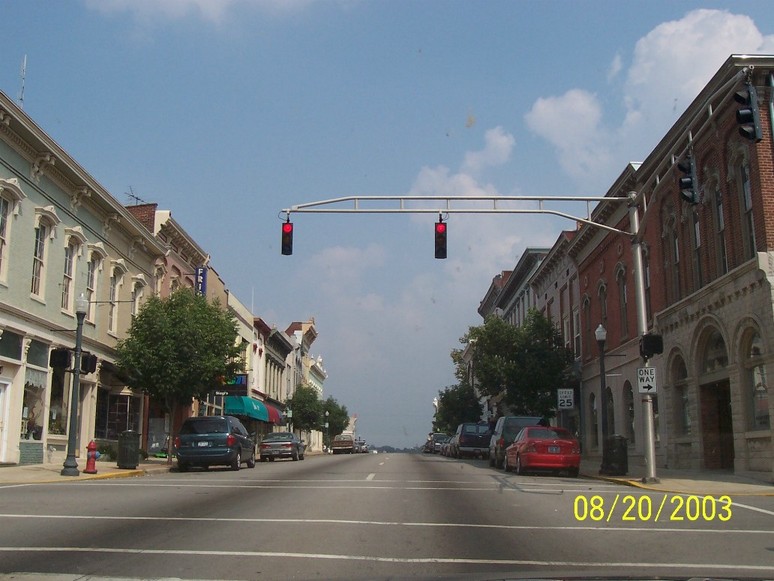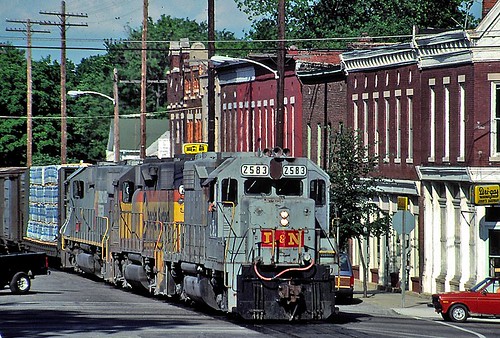Blue Highways: Lexington, Kentucky
 Click on Thumbnail for MapUnfolding the Map
Click on Thumbnail for MapUnfolding the Map
Meandering around Kentucky, we accompany William Least-Heat Moon (LHM) on his drive around America in his van, Ghost Dancing. Check out the map for our current locale.
Book Quote
"Along the Leestown Road, near an old whitewashed springhouse made useless by a water-district pipeline, I stopped to eat lunch. Downstream from the spring where butter once got cooled, under peeling sycamores, the clear rill washed around clumps of new watercress....
"Had I gone looking for some particular place rather than any place, I'd never have found this spring under the sycamores. Since leaving home, I felt for the first time at rest. Sitting full in the moment, I practiced on the god-awful difficulty of just paying attention. It's a contention of Heat Moon's - believing as he does any traveler who misses the journey misses about all he's going to get - that a man becomes his attentions. His observations and curiousity, they make and remake him...
"....Maybe the road could provide a therapy through observation of the ordinary and obvious, a means whereby the outer eye opens an inner one. STOP, LOOK, LISTEN, the old railroad crossing signs warned. Whitman calls it 'the profound lesson of reception.'
"....In Lexington, I passed row after row of tobacco warehouses and auction barns on my way into the thousand square miles of bluegrass wold once called "God's footstool," a fertile land where pumpkin vines grow so fast they wear out the melons dragging them along. So they say."
Blue Highways: Part 1, Chapter 10
Lexington, Kentucky
How do you travel? Do you travel with the idea that you must see as much as possible in places that you go? Or do you travel with minimal goals, rest and relaxation in mind?
My wife and I are often of two minds about our vacations. When we go someplace, she wants to do as many things that are available and which we have time to do. If she plans our days, then we are usually going from one place to another - breakfast at a nice restaurant, then the morning looking at an outdoor public art exhibit, lunch, afternoon at a museum, dinner, then perhaps a play or some other activity for the evening. She is very active, outgoing and wants to see as much as a place has to offer.
I frustrate her a lot, because I am less of a planner. In truth, I tend to let her plan things and go along, but at times I find myself getting tired keeping up with her boundless energy for sights and activities. An afternoon sitting at an outdoor cafe and watching people go by would be something that I would schedule, but doing so might mean we miss something.
There's nothing wrong with either way of traveling. Some travel for rest and relaxation, and some travel for sights and activities. It depends on what we want. But the quote by LHM that I pick above is a good reminder of keeping our perspectives no matter how we travel. Sometimes there is beauty in the ordinary and obvious. Sometimes the quiet and mundane hold secrets. Does it matter if we are spending two hours examining a painting in a museum - just sitting there and letting the color and technique and image wash over us - or sitting in a living artwork of a wooded spring and hearing the sounds of the birds and the buzzing of the insects?
My own experience of this beauty in the ordinary came under most extraordinary circumstances. In Big Bend National Park, on the west side of the Chisos Mountains, the road heads straight for the Rio Grande until you descend off a mesa down into the river valley. At the top of the mesa, you can look over many square miles of desert where the vegetation is very sparse. But in the middle of it, seen from probably twenty miles away, is a huge cottonwood tree. It stands out in the desert like a beacon. I promised myself I would hike to it someday.
My chance came with a friend. I told him about my goal, and he was willing. We set off down the Chimneys Trail and at the Chimneys, a set of rocks that poke out of the desert, we went off trail and headed toward the tree rising in the distance. In the desert, the distances are not what we seemed. We hiked for probably 2 hours, crossing five arroyos each deeper than the last. At the edge of the last arroyo, we reached the tree, but it was surrounded by impenetrable brush on each side, until we went to the west side where there was a way in. The tree had its own amazing little ecosystem. Clearly it drew from an underground spring, and it was so lush it literally dripped water on us. We rested and slept under the tree for probably two hours, completely refreshed after our ordeal through the desert to get there. Insects buzzed, birds twittered. In the midst of the sun-blasted silence of the desert it teemed with life that anywhere else would have seemed ordinary, but there seemed like an amazing miracle.
STOP, LOOK, LISTEN is what we had to do in that extraordinary place in Big Bend. I think perhaps all of us should do more of that. And speaking of stopping, looking and listening, Lexington is an excellent place to try it. I've been there twice, though the second time was the time I got a more in-depth view of the city. My wife finds her stop, look and listen moments at farmers markets, and Lexington has some nice architecture downtown. And, if you like rolling hills with lots of horse farms and beautiful horse, Lexington will please. Finally, the Keeneland Horse Racing Facility holds a horse sale and at those times, you might see Lexington locals mingling with famous American horse-racing aficionados, Arabian princes and European royalty.
If you want to know more about Lexington
Ace Weekly (alternative newspaper)
City Guide (alternative newspaper)
Lexington Convention and Visitors Bureau
Lexington Farmers Market
Lexington Herald-Leader (newspaper)
The Lexington Project (blog)
Life in Lexington, Kentucky (blog)
Now Eat This! (blog posts about Lexington restaurants)
Transylvania University
University of Kentucky
Urban Spoon Lexington (food)
Wikipedia: Lexington
Next up: Brooklyn Bridge/Kentucky River Palisades




 Saturday, June 19, 2010 at 9:11AM
Saturday, June 19, 2010 at 9:11AM

